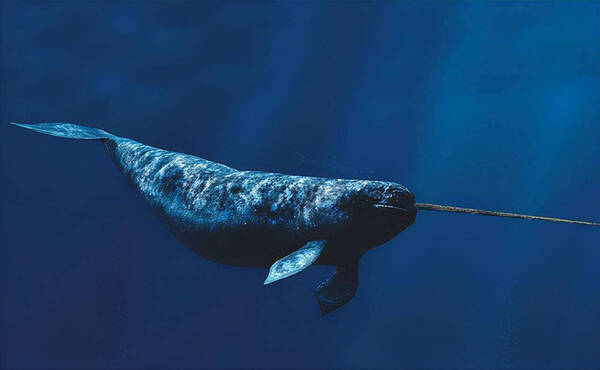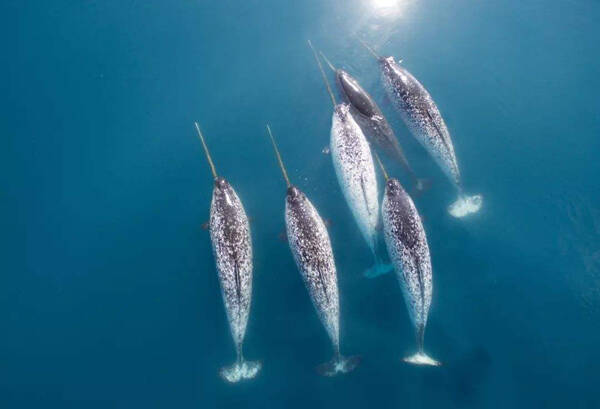Monodon monoceros
IUCN
LCBasic Information
Scientific classification
- name:Monodon monoceros
- Scientific Name:Monodon monoceros,Narwhal、Unicorn Whale,Narwhal, Lance Whale
- Outline:Ungulata
- Family:Artiodactyls Odontoceti Narwhal
Vital signs
- length:4-4.5m
- Weight:1000-1600kg
- lifetime:About 50 years
Feature
There is a long tooth on the head, hence the name
Distribution and Habitat
Origin (sea): Canada, Greenland, Russia, Svalbard and Jan Mayen Island.
Roaming area (sea): Germany, Iceland, the Netherlands, Norway, the United Kingdom, the United States.
Narwhals are the most northerly whales, distributed discontinuously near the Arctic, mostly north of the Arctic Circle and the edge of the ice cap, and rarely move south of 70 degrees north latitude. They are most common in the Canadian Arctic Highlands. According to biologists, 85% of the narwhals are distributed in the Canadian Arctic Highlands.
Appearance
The narwhal has a small, round head, an inconspicuous beak, a protruding frontal ridge that is slightly upturned in front of the mouth, a flexible neck with a few neck wrinkles, canine teeth protruding from the left upper jaw outside the lip and up to 2 to 3 meters in length, no dorsal fin, and a low fleshy bulge on the back half of the back. The body color changes significantly with age. The calves are mottled gray or brown-gray, 1 to 2 years old are purple-gray, adults are gray with black or dark brown patches, and old whales are almost completely white.
Details
The scientific name of narwhal: Monodon monoceros, foreign names Narwhal, Unicorn Whale, no subspecies.

As a protected Arctic species, narwhals are social animals that live mainly in the northern end of the Atlantic Ocean and the Arctic Ocean. A small number of narwhals are also found in the Greenland Sea. The Inuit like to hunt narwhals for their tusks, meat and skin. Scientists have long known that narwhals can dive about 900 meters in the sea at a nearly vertical angle, and repeat this action many times a day, which is definitely a diving expert.
Narwhals are carnivores, mainly feeding on bottom-dwelling organisms such as flounder in winter, and mainly on Arctic cod, flounder and other fish in summer.
Narwhals are seasonal breeders. The gestation period is about 15.3 months, the mating season is from March to May, and the calving is between July and August of the following year. The duration of lactation is unknown, but it is speculated to be equivalent to the 20-month lactation period of the beluga whale (Delphinapterus leucas). The interval between calving is usually 3 years. Each birth has one calf (there are also some records of twins). The calf leaves the mother whale's womb with its tail first and its head last. The blubber layer of newborn whales is 25 mm thick, the body length is 1.5 to 1.7 meters, and the weight is 80 kg. They can swim after birth, but they are still nurtured by the female whale for a period of time. Both sexes usually reach sexual maturity at 4 to 7 years old. The mature female whale is 4 meters long and weighs 900 kg; the male whale is 4.7 meters long and weighs 1,600 kg. The lifespan of wild narwhals is about 50 years, and captive breeding has not been successful.

People often call it the ice whale because it always follows the ice fields that advance and retreat with the seasons. This habit may be related to the killer whale, the main natural enemy of the narwhal. Because the killer whale has a high dorsal fin and must avoid the impact of floating ice, the narwhal's body shape seems to be designed for activities in the ice. They have no dorsal fin, only a 5 cm high and 10 cm long front ridge.
Narwhals' natural enemies include killer whales, walruses, polar bears, and sharks; however, none of these are as powerful as humans. Eskimos have hunted narwhals for centuries for their valuable tusks and thick skin; eating their skin raw is a traditional delicacy; the meat is fed to dogs, and the blubber and fat are used for burning and lighting. Currently, the Inuit in Canada hunt narwhals with high-speed motorboats and powerful rifles, causing unnecessary harm because at least half of the injured narwhals will sink or escape, but still die; although the annual killing quota is in the hundreds, the total number of slaughters is often much higher than this.
Narwhals are generally not considered to be in danger of extinction. Even so, the Convention on International Trade in Endangered Species of Wild Fauna and Flora still lists narwhals as requiring monitoring and regulation of the trade of their tusks to prevent the species from falling into danger of extinction.
Although it is called "narwhal", the long thing sticking out of its front is not a horn, but a tooth. What is the use of the tusk of this marine mammal? This question has always puzzled scientists because although it is called a tooth, it does not conform to the general principle of teeth. It is almost half the length of the narwhal body and usually grows from the upper jaw and left side of the mouth of male narwhals. You can imagine what it would look like if a 2-meter-tall person had a 1-meter-long tusk. In addition, unlike the curved teeth of Elephants-Are-Endangered.html">elephants and warthogs, narwhal teeth are naturally straight. There are spiral patterns on it, rotating to the left around the same axis. Scientists speculate that the spiral tusks may minimize breakage, and previous studies have shown that the spiral helps narwhals grow straighter during development. Another unique feature of narwhal teeth is that they are gender specific. This type of tusk is common in male narwhals, but female narwhals do not have it. Female narwhals also have exposed teeth, but they are very short.
Listed in Appendix II of the Convention on the Conservation of Migratory Species of Wild Animals (CMS).
Listed in Appendix II of the Convention on International Trade in Endangered Species of Wild Fauna and Flora (CITES).
Listed in the IUCN Red List of Threatened Species: Near Threatened (NT), assessed in 2008.
Listed in the IUCN Red List of Threatened Species in 2021 - Least Concern (LC).
Protect wildlife and eliminate game.
Maintaining ecological balance is everyone's responsibility!








